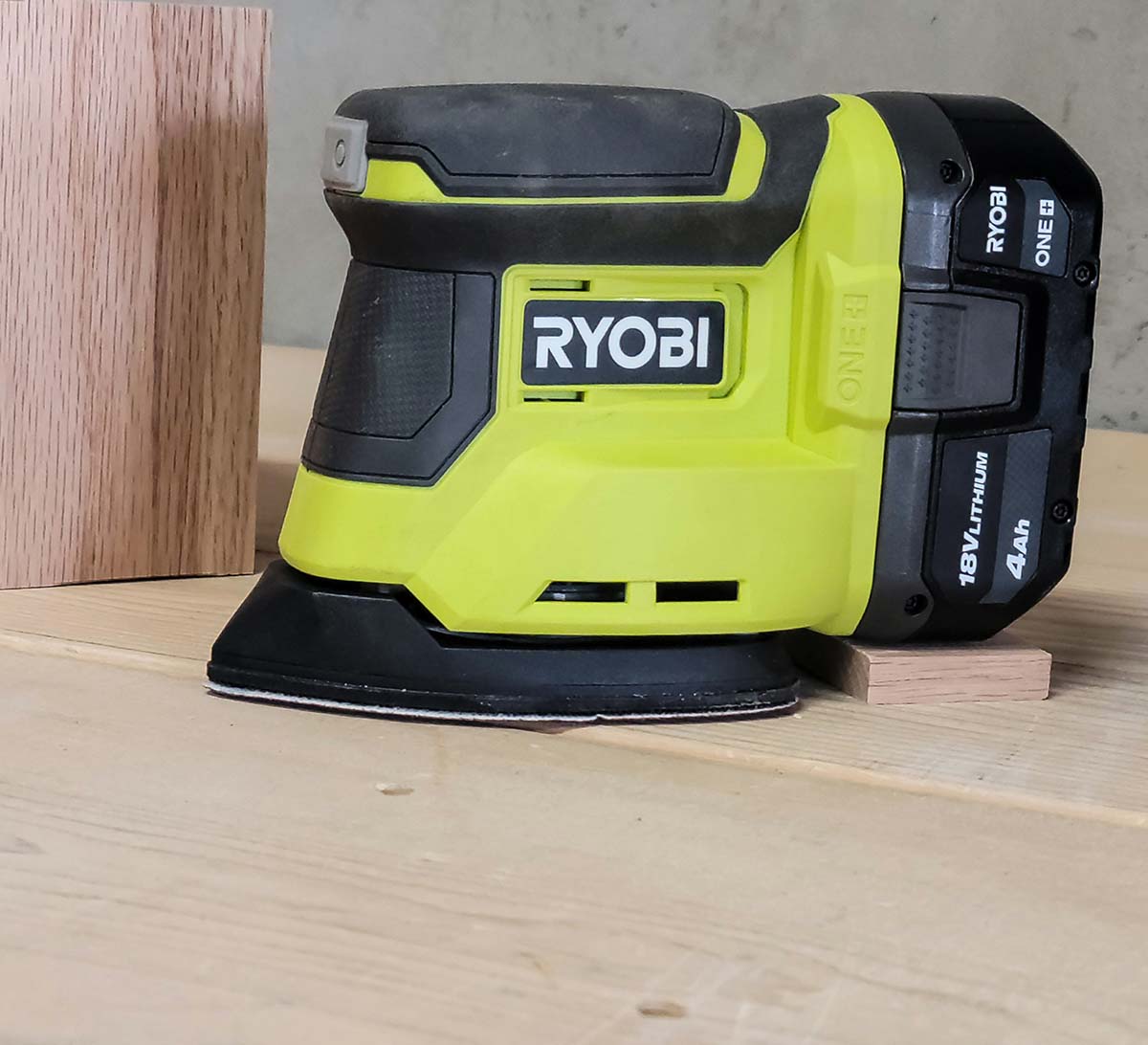We may earn revenue from the products available on this page and participate in affiliate programs. Learn More ›
Perhaps the least-liked phase of a woodworking project is sanding, but today’s power sanders make quick work of what formerly took tedious hours to do by hand. While belt sanders, disc sanders, and drum sanders work well for smoothing large boards and panels, they’re too cumbersome—and often too aggressive—for the fine sanding required to create a flawless finish and sleek feel.
Enter Ryobi’s cordless detail sander. I tested a handful of compact sanders to determine which models qualified as today’s best detail sanders, and the Ryobi Corner Cat Sander earned its spot on the lineup. Ryobi is a flagship brand of The Home Depot, and over the years, I’ve discovered more than a few Ryobi power tools that performed at a high level. The Corner Cat sander is one of them. I tested its sanding ability and noted its quality and overall ease of use. Read on to find out how this detail sander performed in my hands-on testing before deciding whether it deserves a spot in your woodworking shop.
Ryobi 18V Corner Cat Sander: At a Glance
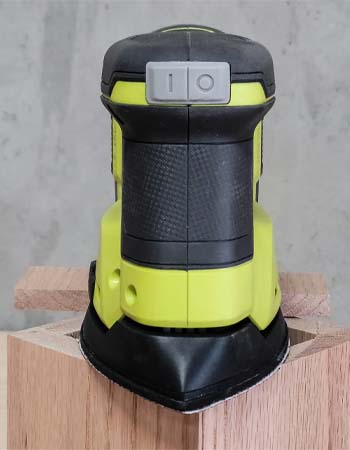
Rating: 8.5/10
PROS
- The Ryobi Corner Cat finish sander comes with a 4Ah battery and a charger
- Features a sanding speed of 11,000 orbits per minute (OPM) for quick smoothing
- Weighs just 1.54 pounds without the battery, making it easy to use overhead
CONS
- Does not feature an inclusive onboard dust collection system
- The accessory for attaching a shop-type vacuum for dust control sells separately
- Only 1 sanding plate is available for use with this detail sander
Get the Ryobi Corner Cat detail sander at The Home Depot for $109.
What is the Corner Cat Ryobi sander?
The Ryobi Corner Cat sander is a compact detail sander explicitly made for sanding wood in corners and tight spots, which are common on handcrafted furniture or decorative cabinet doors. The Corner Cat features a gently rounded triangular base—called a mouse base—that features a hook-and-loop sanding pad attachment. Think Velcro: The mouse-shaped sanding pads adhere to the bottom of the tool’s plate and stay put during use. I didn’t have any trouble with a pad coming loose, and it stayed securely attached until I purposefully pulled it off.
The Corner Cat is battery operated, and it comes with a 4Ah rechargeable lithium-ion battery and a charger. I was impressed with the battery—oftentimes, a power tool will include a lower-capacity battery, but 4Ah is a good capacity and it didn’t run down during my tests, which lasted about 2.5 hours.
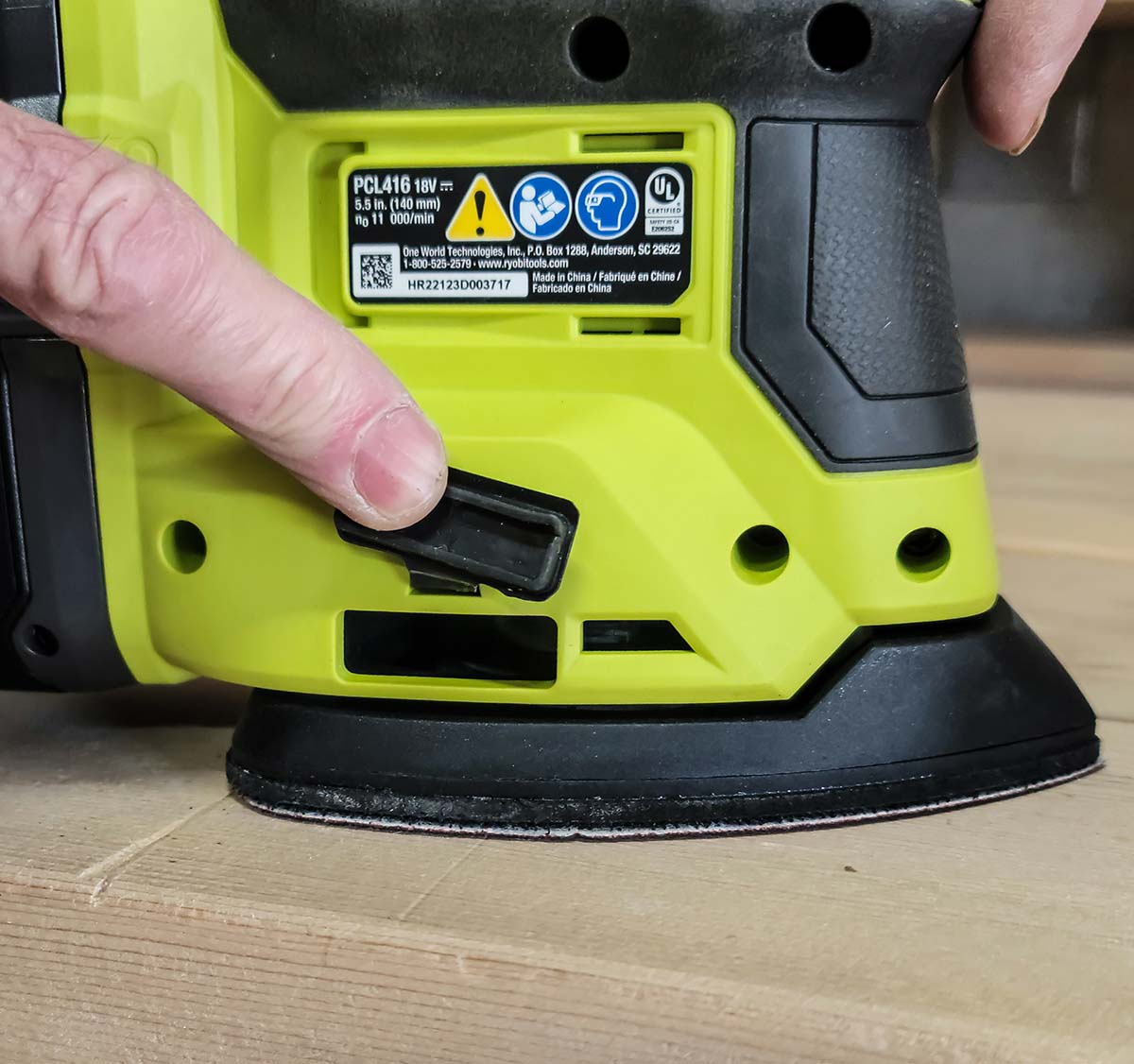
How well does the Ryobi sander perform?
Aside from the pointed tip that’s designed for sanding in tight spots, the primary feature of this Ryobi sander is its powerful motor that produces 11,000 OPM. As an orbital sander, the sanding plate on the Ryobi moves in tiny circles (i.e., orbits), which reduces the risk of cross-grain sanding marks. While some marks can occur with any power sander, after using the Ryobi 18V on both hardwood and softer pine boards, I only found a few superficial scratch marks. I was able to buff those off quickly by hand with a few swipes of micro-grit sandpaper.
Whether you’re using the Corner Cat, a different finish sander, or sanding by hand, follow good sanding techniques to get the best results. These include:
- Using coarser-grit sandpaper first, followed by successively finer grits.
- Keeping the sander moving when it’s turned on—don’t let it sit in one spot.
- Not pressing the sander into the wood—let the weight and the movement of the tool do all the work.
- Moving the sander back and forth with the direction of the wood grain rather than perpendicular to the grain.
The Corner Cat is light, weighing just 1.54 pounds without the battery and less than 3 pounds with the battery attached. The sander performed best when I took my time and let it do all the work.
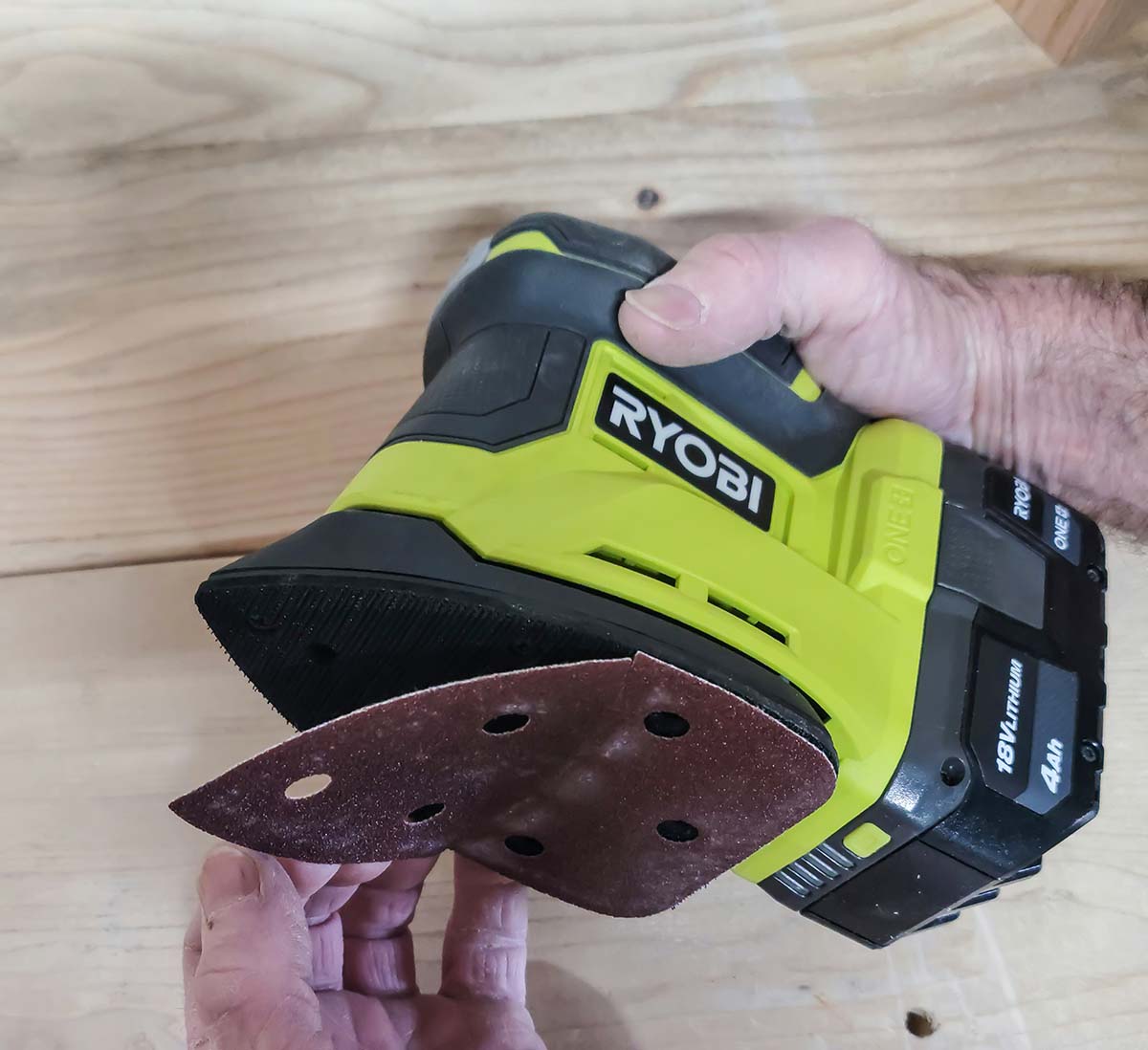
Is this compact Ryobi sander easy to use?
This is one of the easiest detail sanders I’ve ever used, and that’s primarily because it didn’t come with a bunch of bells and whistles I had to learn before I could start testing.
The 4Ah battery snapped into the charger, and it had an indicator that allowed me to monitor the charging progress. It took less than 2 hours to charge the battery completely. Installing the battery on the sander was just as simple—it snapped right into place on the back side. Removing it requires depressing two buttons on either side of the battery while pulling it out. This requires a fairly strong grip, but most users will likely have no problem removing the battery.
The Ryobi detail sander has an on/off rocker button on the front of the tool, which I found easy to operate by feel. Push right, it turns on; push left, it turns off. The tool came with two sample sanding pads, but woodworkers can order more to keep on hand for projects. It’s simple to line up the precut sanding pads with the sanding plate and then smooth them on. They stick well, but they are not difficult to peel off.
How does this Ryobi detail sander compare to other detail sanders?
Performance-wise, the Ryobi Corner Cat sander holds its own against the other detail sanders I tested, except for two drawbacks. First, the Ryobi lacks an onboard dust-collection system. The other detail sanders I tested had small bags or canisters for capturing sanding dust. The Corner Cat does offer a method for collecting dust via an accessory that attaches to a shop-type vacuum, but it’s sold separately, so I couldn’t test that feature.
The other difference is the lack of sanding-plate options. The other detail sanders I tested came with interchangeable plates, including square, rectangular, round, and/or thin narrow plates called finger sanders for smoothing between chair rails and other limited spots.
That said, most woodworkers would probably agree that the mouse plate is the most functional sanding-plate configuration for a detail sander. Plus, I’m one of those people who likes designated tools in my workshop that I can grab as needed, rather than spending time detaching one plate and attaching another with a screwdriver. So for me—and perhaps other woodworkers—a single plate is a benefit, not a detriment.
Additionally, the ergonomic grip on the Ryobi sander is quite nice. It’s positioned directly over the sanding plate, which offers maximum control, and it features padding that reduces vibration. All in all, it’s a decent little detail sander.
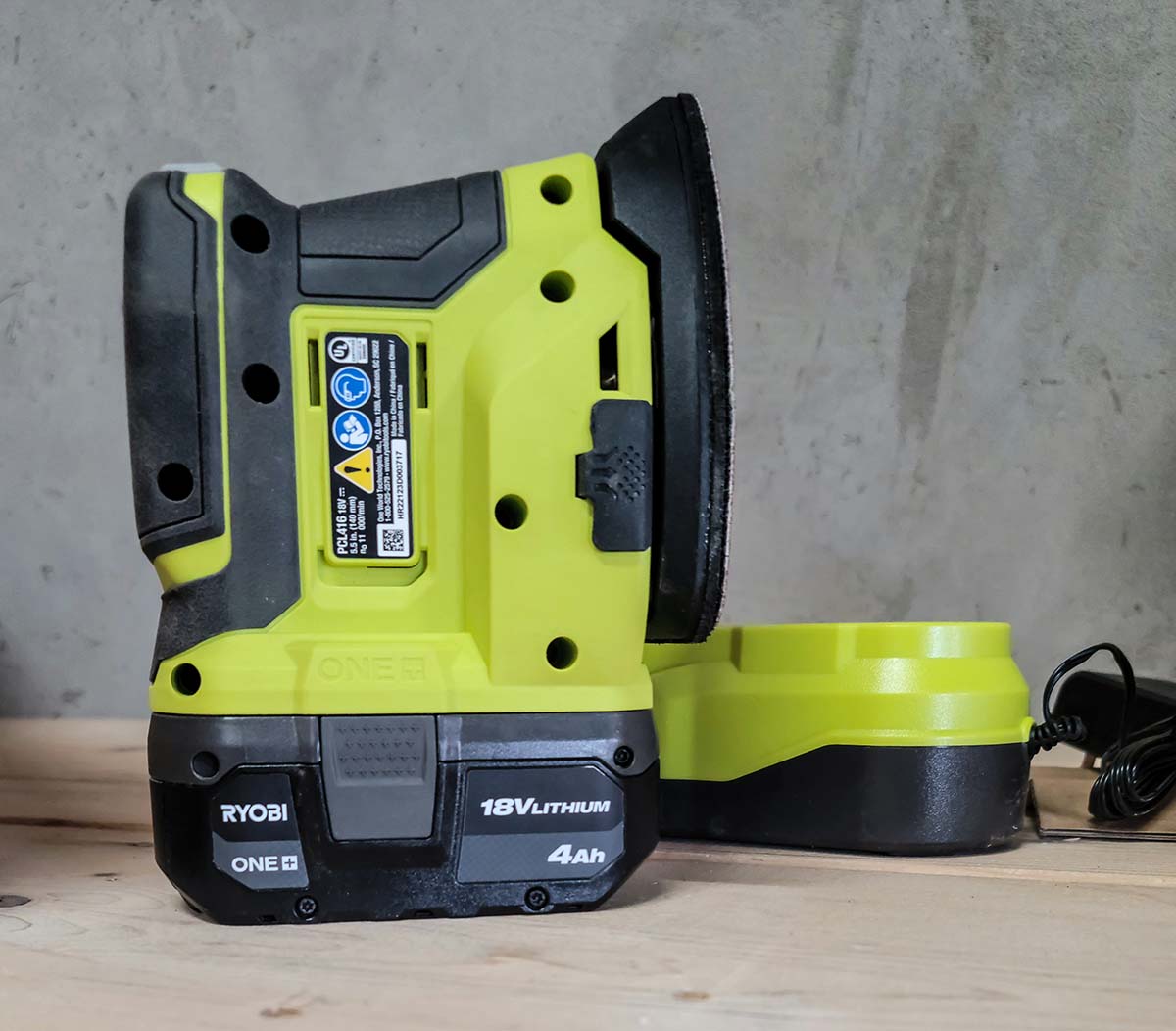
Is this compact Ryobi woodworking sander a good value for the price?
At the time of writing, the Corner Cat sander sells for $109 at The Home Depot. This is a reasonable price for a midrange cordless detail sander. Compared to the other detail sanders I tested for our comprehensive lineup, the Ryobi was more expensive than the corded models but less expensive (by about $200!) than our Best Overall pick.
To collect dust, remember that you’ll need to purchase the accessory that attaches the Corner Cat to a shop-vacuum hose, and that will add another $14 to the total cost. The cost to buy additional sanding pads runs about $5 for a nine-piece set.
I consider the Corner Cat sander to be worth the price primarily because it’s a cordless sander, and the included battery is relatively high capacity (4Ah). While I typically use detail sanders in my woodworking shop—where I can access outlets—I’m not fond of cords. I’ll welcome the need to charge and recharge a battery to keep from being limited by the length of a tool’s cord. It’s so much more convenient to use a cordless power tool, so I feel this Ryobi sander is well worth the cost.
Where to Buy the Ryobi Corner Cat Detail Sander
Get the Ryobi Corner Cat detail sander at The Home Depot for $109.
Meet the Tester
Glenda Taylor is a product tester and writer specializing in construction, remodeling, and real estate. She and her husband own a general contracting company, and she is experienced in both residential and commercial building applications. Taylor tests a wide range of power tools as well as other home improvement, household, and lawn-and-garden products.

